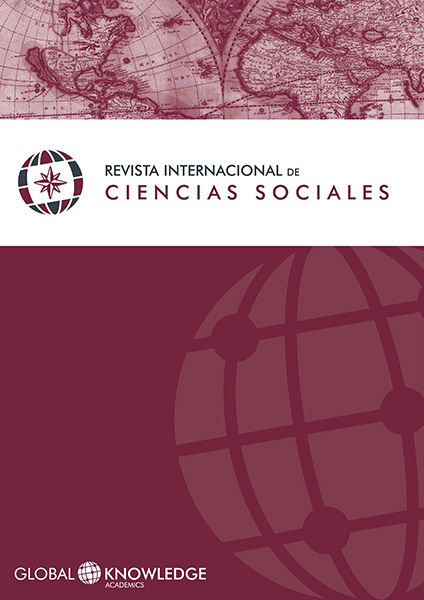Security and Migration: Foreign Women in Spanish Prisons
DOI:
https://doi.org/10.37467/gka-revsocial.v4.789Keywords:
Spain, Women, Migrations, Prison, SecurityAbstract
This article aims to study and analyze women into the Spanish prisons, where exist around 6.000 women prisoners. The high percent of foreign women in prison who committed crimes against public health (77,8%), are causing a set of conflicts and violence (direct, structural and cultural/symbolic) which causes an insecurity perception within Spanish society. The international provenance of this women, many of this from Latin American, constitute different realities and experiences that lead us to the world of drugs, prostitution, theft and illegal immigration.
Downloads
Global Statistics ℹ️
|
684
Views
|
469
Downloads
|
|
1153
Total
|
|
References
Almeda, E. (2010). Privación de libertad y mujeres extranjeras. Viejos prejuicios y nuevas desigualdades. En F.T. Añaños (coord.), Las mujeres en las prisiones. La educación Social en contextos de riesgo y conflicto (pp. 201-234). Barcelona: Gedisa.
Amnistía Internacional [AI] (2008). España: Entre la desgana y la invisibilidad, políticas del Estado español en la lucha contra el racismo. Madrid.
Appadurai, A. (2007). El rechazo de las minorías. Ensayo sobre la geografía de la furia. Barcelona: Tusquets.
Bauman, Z. (1997). Los extraños de la era del consumidor: del Estado del Bienestar a la prisión. Barcelona: Paidós.
Castillo Algarra, J. y Ruiz García, M. (2010). Mujeres extranjeras en prisiones españolas. El caso andaluz. Revista Internacional de Sociología, 2 (68), pp. 473-498. DOI: https://doi.org/10.3989/ris.2008.05.15
Del Pozo Serrano, F.J.; Jiménez Bautista, F. y Turbi Pinazo, Á.M. (2013). El Tratamiento con mujeres: Actuación socioeducativa y sociolaboral en prisiones. Pedagogía Social. Revista Interuniversitaria, 22, pp. 57-72. DOI: https://doi.org/10.7179/PSRI_2013.22.05
Fenton, S. (1999). Ethnicity. Basingstoke: Macmillan. DOI: https://doi.org/10.1007/978-1-349-27560-1
Friedman, J. (1994). Identidad cultural y proceso global. Buenos Aires: Amorrortu. DOI: https://doi.org/10.4135/9781446222195
García España, E. y Díez Ripollés, J.L. (2012). Realidad y Política penitenciarias. Málaga: Instituto Andaluz Interuniversitario de Criminología.
Garrido Medina, L. (2005). La inmigración en España. En J.J. González y M. Requena (eds.), Tres décadas de cambio social en España (pp. 127-164). Madrid: Alianza Editorial.
Hawkins, G. (1983). Prison Labour and Prison Industries. En M. Tonry y N. Morris (eds.), Crime and Social. Chicago: University of Chicago Press. DOI: https://doi.org/10.1086/449094
Huntington, S.P. (1997). El choque de civilizaciones y la reconfiguración del orden mundial. Barcelona: Paidós.
Instituto Nacional de Estadística [INE] (2000-2012). Datos del Padrón Nacional, Comunidad Autónomas de Andalucía, en http://www.ine.es/jaxi/tabla.do [Consultado el 10 de mayo de 2013].
Justice: A Review of Research, 5 . Chicago: University of Chicago Press.
Jiménez Bautista, F. (2009). Migration in Spain: Andalusia and Granada. International Research. Society, Politics, Economics, 1, pp. 94-107.
Jiménez Bautista, F. (2012). Conocer para comprender la violencia: origen, causas y realidad. Convergencia. Revista de Ciencias Sociales, 58 (19), pp. 13-54.
Martín Palomo, M.T., Miranda López, MªJ. y Vega Solís, C. (2005). Delitos y fronteras. Mujeres extranjeras en prisión. Madrid: Instituto de Investigaciones Feministas/Universidad Complutense/Universidad del País Vasco.
Migallón, P. y Voria, A. (2007). Guía práctica para la intervención grupal con mujeres privadas de libertad. Programa de intervención en salud desde un enfoque de género. Madrid: Instituto de la Mujer/Ministerio de Igualdad.
Morin, E. (2009). ¿Hacia el abismo? Globalización en el siglo XXI. Barcelona: Paidós. Reglamento Penitenciario Español [RPE] (2012). www.agpd.es [Consultado el 9 de junio de 2013].
Ribas Mateos, N. y Martínez, A. (2003). Mujeres extranjeras en las cárceles españolas. Revista Sociedad y Economía, 5, pp. 65-80.
Secretaria General de Instituciones Penitenciarias [SGIP] (2013). Estadística Penitenciaria, [Consultado el 1 de julio de 2013].
United Nations [NU] (2009). International Migration Report 2006. Global Assessment. New York.
Yagüe Olmos, C. (2011). Objetivos estratégicos de Tratamiento Penitenciario. Tema 1: las Políticas de intervención. Máster Universitario en Administración y Gestión de Centros Penitenciarios. Madrid: UNED.
Downloads
Published
How to Cite
Issue
Section
License
Those authors who publish in this journal accept the following terms:
-
Authors retain copyright.
-
Authors transfer to the journal the right of first publication. The journal also owns the publishing rights.
-
All published contents are governed by an Attribution-NoDerivatives 4.0 International License.
Access the informative version and legal text of the license. By virtue of this, third parties are allowed to use what is published as long as they mention the authorship of the work and the first publication in this journal. If you transform the material, you may not distribute the modified work. -
Authors may make other independent and additional contractual arrangements for non-exclusive distribution of the version of the article published in this journal (e.g., inclusion in an institutional repository or publication in a book) as long as they clearly indicate that the work was first published in this journal.
- Authors are allowed and recommended to publish their work on the Internet (for example on institutional and personal websites), following the publication of, and referencing the journal, as this could lead to constructive exchanges and a more extensive and quick circulation of published works (see The Effect of Open Access).













